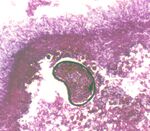Difference between revisions of "Category:Fungi"
| Line 13: | Line 13: | ||
<big>'''[[Fungal Structure]] | <big>'''[[Fungal Structure]] | ||
| − | + | '''[[Types of Fungi]] | |
| − | |||
| − | |||
| − | |||
| − | |||
| − | |||
| − | |||
| − | |||
| − | |||
| − | |||
| − | |||
=[[Fungal Reproduction]]= | =[[Fungal Reproduction]]= | ||
Revision as of 13:36, 17 May 2010
Introduction
There are many different organisms in the fungal lineage which include mushrooms, rusts, smuts, puffballs, truffles, morels, moulds and yeasts, as well as many lesser known organisms. fungi are eukaryotic and heterotrophic organisms which posess a chitinous cell wall. Sexual and asexual reproduction of the fungi is commonly via spores, often produced on specialized structures or in fruiting bodies. Some species have lost the ability to form reproductive structures, and propagate solely by vegetative growth.
Fungi are abundant in soil, vegetation, water and on decaying material and wood. Fungi have a eukaryotic cell structure and are able to grow as branching or filamentous forms (mycelia) or as single cells (yeasts).
The study of fungi is called mycology. Fungi are fundamental for life on earth in their roles as symbionts and by playing a role in xenobiotics, a critical step in the global carbon cycle. Many fungi produce toxins, antibiotics, and other secondary metabolites, some of which cause diseases of animals (as well as plants).
Although there are over 50,000 identified species of fungi, only a few hundred are known to be pathogenic, causing infections known as mycoses (mycology being the study of fungi). Fungi are nonphotosynthetic organisms (lack chlorophyll) which are restricted to a parasitic or saprophytic existence. They are abundant in soil, vegetation, water and on decaying vegetation and wood. Fungi have a eukaryotic cell structure and are able to grow as branching or filamentous forms (mycelia) or as single cells (yeasts).
Fungal Reproduction
Any fragment of hyphae can grow to form a new colony (if it is not too badly damaged). However, the main method of fungal reproduction is through spores which are produced in very large numbers. There are different types of spores: vegetative, asexual and sexual.
Vegetative spores can be divided into arthrospores and chlamydospores. Arthrospores are formed when septate hyphae disarticulate into separate cells. Arthrospores are usually formed by dermatophytes. Chlamydospoes are formed by segmentation of mycelium. They are thick walled, enlarged, resting spores which contain reserve food material and can remain viable after the rest of the mycelium has died. Budding from the ends or sides of the parent cell forms blastospores, for example, in Candidosis infections.
Asexual spores are either sporangiospores or conidiospores. Sporangiospores are formed when the cytoplasm cleaves within a sporangium (multinucleate segment of hyphae), producing either naked zoospores which have one or more flagella and are liberated through a hole in the sporangial wall or producing aplanospores. Aplanospores are non-motile and walled and are released when the sporangial wall breaks down. Conidiospores, such as Aspergillus can be formed directly from the mycelium, produced within a specialised fructification or can be formed externally by the abstriction of a conidiophore. Different types of conidia can be produced which differ in cell size and number and are called either microconidia (small and unicellular) or macroconidia (large and multicellular).
The sexual spores are divided into four categories depending upon the spores produced and their morphology. Zygomycetes are primitive fungi with a non-septate mycelium. The sexual spores are oospores or zygospores (the asexual spores are produced in a sporangium). Ascomycetes are higher fungi. They have a septate mycelium and the sexual spores are called ascospores (the asexual spores are conidia). Basidiomycetes are also higher fungi with a septate mycelium which has clamp connections. The sexual spores are basidiospores (the asexual spores are produced externally). Deuteromycetes are an artifical group of fungi which have an unknown sexual state.
Major pathogenic fungi
Superficial: These infections affect only the skin, hair, nails etc.
- Generally not dangerous
- Examples- Hortaea werneckii, causing tinea nigra, and Piedraia hortae, causing black piedra
Cutaneous: including dermatophytoses
- Only affect superficial keratinized tissue- skin, hair and nails
- Again generally not dangerous
- Examples- Candida albicans, causing candidiasis of the skin and nails and Microsporum species
Subcutaneous: Usually cause chronic localised infections of the skin and underlying dermis
- Normally reside in soil and vegetation, entering the skin through cuts and grazes
- Can occasionally affect the deep tissues, e.g. bones and muscles
- Examples- Sporothrix schenkii, causing sporotrichosis, Madurella mycetomatis causing mycetoma
Systemic: Also known as deep, endemic or primary
- Usually serious
- Sometimes fatal
- Examples- Histoplasma capsulatum causing histoplasmosis, Blastomyces dermatitidis causing blastomycosis
Opportunistic: Ubiquitous fungi that affect only susceptible hosts; immunocompetent individuals are normally resistant
- Examples- Aspergillus fumigatus, causing aspergilliosis, Cryptococcus neoformans, causing cryptococcosis
Immunity to Fungi
Cutaneous and superficial fungal infections are normally self-limiting, with recovery associated with a resistance to re-infection. As hosts often develop delayed-type hypersensitivity, this resistance appears to be cell-mediated.
- T cell immunity- it is thought that helper T cells release cytokines to activate macrophages to fight the infection
- Neutrophils- there is now growing evidence for the role of neutrophils in some infections of the respiratory system, with defensin and the nitric oxide pathways implicated
Further Links
Fungal Diseases
<ncl style=compact maxdepth=3 headings=bullet headstart=2 showcats=1 showarts=1>Category:Fungi</ncl>
References
Special accreditation for the use of lecture notes, images and input from:
Professor Andrew N. Rycroft, BSc, PHD, C. Biol.F.I.Biol., FRCPath
Other Sources
- Carter and Chengappa: Essentials of Veterinary Bacteriology and Mycology, Fourth edition
Subcategories
This category has the following 4 subcategories, out of 4 total.
C
S
Y
Pages in category "Fungi"
The following 8 pages are in this category, out of 8 total.
